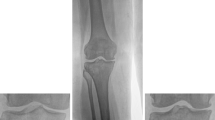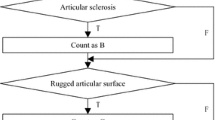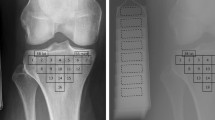Abstract
Purpose
To develop an image analysis method that can automatically find correlations between a set of plain radiographs and continuous clinical or physiological indicators.
Methods
Knee X-rays taken from the Baltimore Longitudinal Study of Aging are used in this study. The computer analysis method is based on the WND-CHARM image feature set filtered by using the Pearson correlation of each feature with the continuous variable, and the estimated value is determined by a weighted nearest neighbor interpolation.
Results
Experimental results using 300 radiographs show that the proposed method can correlate knee X-rays with physiological indicators such as sex, age, height, weight, and BMI. For instance, the Pearson correlation between the X-ray images and the height and weight were 0.59 and 0.62, respectively.
Conclusions
Using computer analysis, X-ray images can be correlated to continuous physiological variables that might not have a direct and straightforward link to the visual content of the radiograph. This approach of radiology image analysis can be used in population studies for detecting biomarkers and also in genome-wide association studies for studying the link between genes and anatomy.
Similar content being viewed by others
References
Altman RD, Gold GE (2007) Atlas of individual radiographic features in osteoarthritis, revised. Osteoarthr Cartil 15: A1–A56
Bishop CM (2006) Pattern recognition and machine learning. Springer, New York
Boniatis I, Costaridou L, Cavouras D et al (2006) Osteoarthritis severity of the hip by computer-aided grading of radiographic images. Med Biol Eng Comput 44: 793–803
Boniatis I, Cavouras D, Costaridou L et al (2007) Computer-aided grading and quantification of hip osteoarthritis severity employing shape descriptors of radiographic hip joint space. Comput Biol Med 37: 1786–1795
Ding M, Dalstra M, Danielsen CC et al (1997) Age variations in the properties of human tibial trabecular bone. Bone Joint Surg Br 79: 995–1002
Ding M, Odgaard A, Linde F et al (2002) Age-related variations in the microstructure of human tibial cancellous bone. J Orthop Res 79: 615–621
Enquist H (2007) Narcissus’s new mirror: body images and meaning. J Art Technol 5: 3
Haralick RM, Shanmugam K, Dinstein I (1973) Textural features for image classification. IEEE Trans Syst Man Cyber 6: 269–285
Kellgren JH, Lawrence JS (1957) Radiologic assessment of osteoarthritis. Ann Rheum Dis 16: 494–501
Khodadadyan-Klostermann C, Von Seebach M, Taylor WR et al (2004) Distribution of bone mineral density with age and gender in the proximal tibia. Clin Biomech 19: 370–376
Lynch JA, Hawkes DJ, Buckland-Wright JC (1991) Analysis of texture in macroradiographs of osteoarthritic knee using the fractal signature. Phys Med Biol 36: 709–722
Murphy RF, Velliste M, Yao J, Porreca G (2001) Searching online journals for fluorescence microscopy images depicting protein subcellular location patterns. In: Proceedings of 2nd IEEE international symposium on bioinformatics and biomedical engineering, pp 119–128
Podsiadlo P, Wolski M, Stachowiak GW (2008) Automated selection of trabecular bone regions in knee radiographs. Med Phys 35: 1870–1883
Podsiadlo P, Dahl L, Englund M et al (2008) Differences in trabecular bone texture between knees with and without radiographic osteoarthritis detected by fractal methods. Osteoarthr Cartil 16: 323–329
Shamir L, Orlov N, Macura T et al (2008) Wndchrm—an open source utility for biological image analysis. BMC Source Code Biol Med 3: 13
Shamir L, Orlov N, Eckley DM et al (2008) IICBU-2008—a benchmark suite for biological imaging. Med Bio Eng Comput 46: 943–947
Shamir L (2008) Evaluation of face datasets as tools for assessing the performance of face recognition methods. Int J Comput Vision 79: 225–230
Shamir L, Ling SM, Scott WW et al (2009) Knee X-ray image analysis method for automated detection of osteoarthritis. IEEE Trans Biomed Eng 56: 407–415
Shamir L, Orlov N, Goldberg IG (2009) Evaluation of the informativeness of multi-order image transforms. In: Proceedings of international conference on image processing, computer vision and pattern recognition, pp 37–42
Shamir L, Ling SM, Scott WW et al (2009) Early detection of radiographic knee osteoarthritis using computer-aided analysis. Osteoarthr Cartil 17: 1307–1312
Shamir L, Ling SM, Rahimi S et al (2009) Biometric identification using knee X-rays. Int J Biometrics 1: 365–370
Shamir L, Macura T, Orlov N et al (2010) Impressionism, expressionism, surrealism: automated recognition of painters and schools of art. ACM Trans Appl Percept 7: 8
Shock NW, Greulich RC, Andres R et al (1984) Normal human aging: the Baltimore longitudinal study of aging. NIH Publication No. 84-2450. Government Printing Office, Washington, DC
St Clair SF, Higuera C, Krebs V et al (2006) Hip and knee arthroplasty in the geriatric population. Clin Geriatr Med 3: 515–533
Stockwell RA (1990) Cartilage failure in osteoarthritis: relevance of normal structure and function—a review. Clin Anat 4: 161–191
Tamura H, Mori S, Yamavaki T (1978) Textural features corresponding to visual perception. IEEE Trans Syst Man Cyber 8: 460–472
Teague MR (1979) Image analysis via the general theory of moments. J Opt Soc Am 70: 920
Woloszynski T, Podsiadlo P, Stachowiak GW (2010) A signature dissimilarity measure for trabecular bone texture in knee radiographs. Med Phys 37: 2030–2043
Author information
Authors and Affiliations
Corresponding author
Rights and permissions
About this article
Cite this article
Shamir, L. A computer analysis method for correlating knee X-rays with continuous indicators. Int J CARS 6, 699–704 (2011). https://doi.org/10.1007/s11548-011-0550-z
Received:
Accepted:
Published:
Issue Date:
DOI: https://doi.org/10.1007/s11548-011-0550-z




